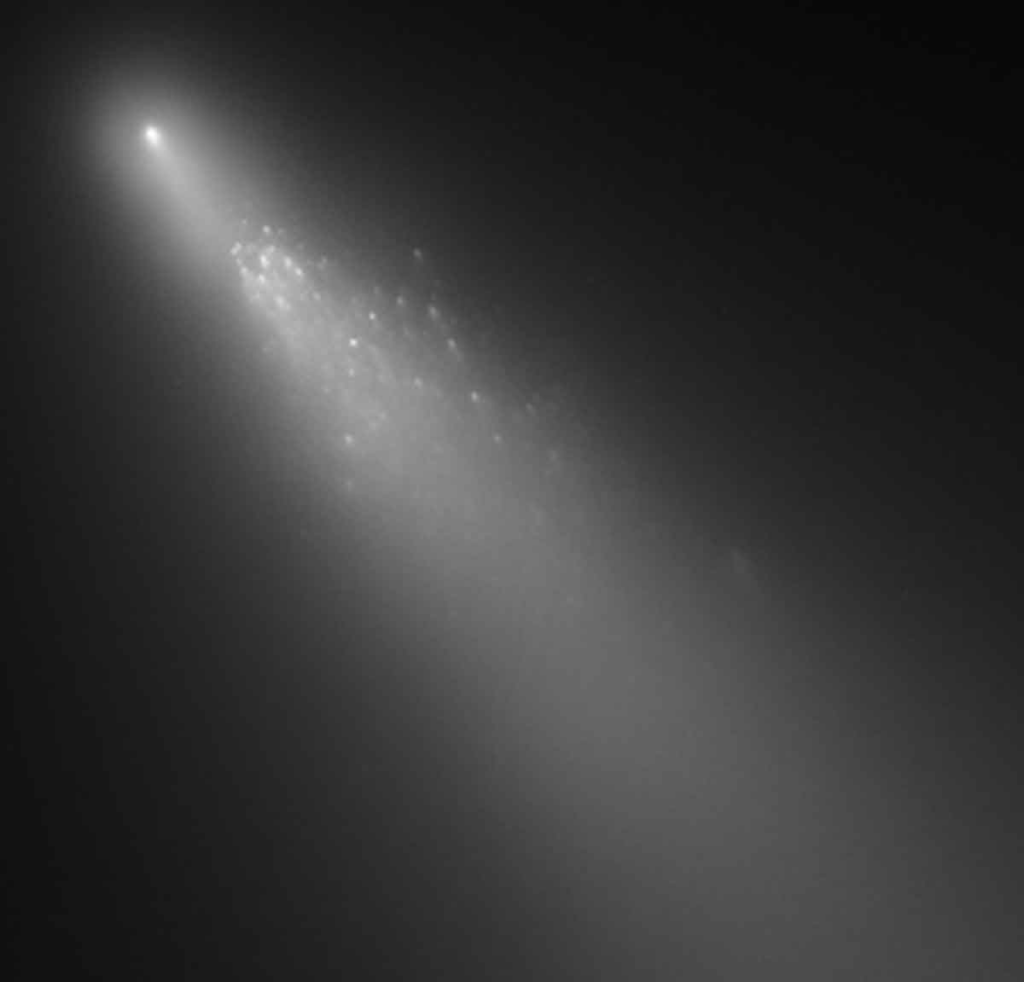Sky Report: May 30-June 5

Fragments of Comet 73P/Schwassmann-Wachmann 3 photographed by the Hubble Telescope in 2006. Image credit: NASA.
In 2007 I was alerted to a brief meteor shower that *might* happen one night, so I went out to look – and was treated to a wonderful shower of many meteors that lasted only 20 minutes. There’s a possibility that something similar will happen again at about 11 p.m. on Monday the 30th. Again, I’ll be watching.
Meteor showers happen when the earth passes through debris shed by comets. Comets are dusty snowballs in elongated orbits around the sun; when they approach the sun and heat up, the ice evaporates (actually sublimates) and the dust frozen within the ice drifts away – to follow in the comet’s orbit. If the earth passes near the orbit of the comet that dust falls as meteors and we have a meteor shower. Showers occur at the same time each year.
Comet 73P/Schwassmann–Wachmann 3 broke up in 1995 and astronomers have been tracking clumps of material ever since. It’s not possible to predict its path precisely, but there’s a chance that the earth will encounter a clump on the 30th, and if so there could be an intense but brief meteor shower that may last as little as 15 minutes. There probably won’t be, but I’ll be watching from 10:30 to 11:30. Meteors will radiate from near the star Arcturus, and they’ll be especially slow at 10 miles/second. Just get comfortable in a dark location and look up. Google “First Meteor Swarm in 20 Years” and “Tau Herculids” for background articles.
More reliable are the planets’ motions in the morning sky. One conjunction that peaked on the 29th actually continues for the next few days and is still well-worth watching. Although we’ve had several great conjunctions recently, while four planets have been passing each other in the morning sky, it’ll be a long dry spell before there’s another.
To set the stage: earlier this month, from left to right (east to west), 45 minutes before sunrise, you’ve seen brilliant Venus, then Jupiter (almost as bright), fainter Mars, and much farther away similarly-faint Saturn. All are in motion eastward against the background stars, each at a different speed which depends mostly on their distance from the sun and thus their orbital speed. Venus zips along at the rapid rate of 1.1° per day (and it rises 1 minute earlier each morning). Jupiter and Saturn move much more slowly because they’re so distant, and they’re comparatively stationary. But Mars is moving relative to Jupiter at 0.7° per day, and you may have been watching it approach Jupiter, pass closest to it on the 29th, and then continue on to the east and distance itself from Jupiter. On the 29th they were a scant 35’ (35 arcminutes) or ½° below Jupiter. They separate slowly and on the 1st they’re still only 2° apart. You’ll see the two together in most binoculars until roughly June 10th, depending on the field-of-view of your binoculars. Mars is 1/16th as bright as Jupiter.
Through a 2021 grant from the Utah Governor’s Office of Economic Opportunity and the Kane County Office of Tourism, Stellar Vista Observatory provides portable telescopes and tripod mounted binocular kits on loan for free to residents and visitors in Kane County. Enhance enjoyment of the night sky! For details or to request a loan, visit https://stellarvistaobservatory.org/discover-the-night-sky/ or drop in to the Kane County Office of Tourism.
The Sky Report is presented as a public service by the Stellar Vista Observatory, a nonprofit organization based in Kanab, Utah, which provides opportunities for people to observe, appreciate, and comprehend our starry night sky. Additional information is at www.stellarvistaobservatory.org. Send questions and comments to John@StargazingAdventures.org.






Comments are closed.